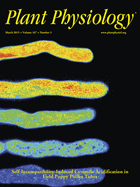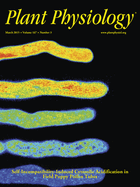
Cover image

On the Cover: Self-incompatibility (SI) is an important genetically controlled mechanism to prevent inbreeding in higher plants. SI involves highly specific interactions during pollination, resulting in the rejection of incompatible (self) pollen. The article by Wilkins et al. (pp. 766–779) describes the pivotal role of SI-induced acidification in mediating programmed cell death (PCD) in the SI response. After an incompatible interaction between the female stigmatic S-determinant, field poppy (Papaver rhoeas) stigma S, and the pollen S-determinant, field poppy pollen S, a signaling cascade is initiated which results in rapid, dramatic acidification of the pollen tube cytosol (green/blue, pH 5.5). Significant acidification occurs within 10 min of SI induction and continues for approximately 60 min. This acidification is essential for the formation of punctate actin foci and PCD in incompatible pollen. The cover shows pseudocolored confocal microscopy images of field poppy pollen tubes labeled with the pH-dependent ratiometric dye, 2,7- bis-(2-carboxyethyl)-5-(and-6)-carboxyfluorescein acetoxymethyl ester. Healthy unchallenged pollen tubes (top two images) have a neutral cytosolic pH (red/orange/yellow; pH 7.15); after SI challenge, the pollen tube cytosol becomes increasingly more acidic as time progresses (yellow/green/pale blue; middle images), reaching pH 5.5 after 60 min (pale blue/dark blue; bottom image). Cover image credits: Katie A. Wilkins (School of Biosciences, University of Birmingham, UK).
Volume 167, Issue 3, March 2015
ON THE INSIDE
On the Inside
BREAKTHROUGH TECHNOLOGIES
Imaging of Lipids in Microalgae with Coherent Anti-Stokes Raman Scattering Microscopy
Lipids are accumulated as giant droplets alongside coalescing emerging droplets under excessive lipid storage, in contrast to the multiple micron-sized droplets formed at normal conditions.
Root System Markup Language: Toward a Unified Root Architecture Description Language
Portability of root architecture data with the Root System Markup Language paves the way for central root phenotype repositories.
Live Imaging of Inorganic Phosphate in Plants with Cellular and Subcellular Resolution
Genetically encoded sensors enable dynamic monitoring of phosphate concentrations in cells and cell compartments of live plants.
Direct Detection of Transcription Factors in Cotyledons during Seedling Development Using Sensitive Silicon-Substrate Photonic Crystal Protein Arrays
Transcription factors in seedling cotyledons are quantified using novel silicon photonic crystal protein arrays and their levels are correlated with transcript abundances.
Articles
BIOCHEMISTRY AND METABOLISM
A Heteromeric Membrane-Bound Prenyltransferase Complex from Hop Catalyzes Three Sequential Aromatic Prenylations in the Bitter Acid Pathway
A membrane-bound prenyltransferase complex is responsible for all prenylations in the bitter acid pathway of hop glandular trichomes.
Reexamination of Chlorophyllase Function Implies Its Involvement in Defense against Chewing Herbivores
A jasmonate-inducible chlorophyllase catabolizes chlorophyll upon tissue disruption to generate compounds that are toxic to insect herbivores.
Phosphoenolpyruvate Carboxylase in Arabidopsis Leaves Plays a Crucial Role in Carbon and Nitrogen Metabolism
Phosphoenolpyruvate carboxylase in Arabidopsis leaves balances carbon and nitrogen metabolism.
ECERIFERUM2-LIKE Proteins Have Unique Biochemical and Physiological Functions in Very-Long-Chain Fatty Acid Elongation
An Arabidopsis protein that lacks enzymatic activity in long-chain fatty-acid condensation nonetheless affects chain length specificity of very-long-chain fatty acid elongation, which is important for cuticle and pollen coat function.
The MYB182 Protein Down-Regulates Proanthocyanidin and Anthocyanin Biosynthesis in Poplar by Repressing Both Structural and Regulatory Flavonoid Genes
A poplar repressor protein negatively regulates flavonoid and proanthocyanidin pathway genes by interacting with other transcription factors.
CELL BIOLOGY
COBRA-LIKE2, a Member of the Glycosylphosphatidylinositol-Anchored COBRA-LIKE Family, Plays a Role in Cellulose Deposition in Arabidopsis Seed Coat Mucilage Secretory Cells ,
A previously uncharacterized protein plays a role in cellulose deposition during the course of seed coat epidermal cell differentiation.
HIGHLY METHYL ESTERIFIED SEEDS Is a Pectin Methyl Esterase Involved in Embryo Development
An Arabidopsis gene is required for normal levels of pectin methylesterase activity and embryo cell expansion during the accumulation of storage reserves.
Importin-α-Mediated Nucleolar Localization of Potato Mop-Top Virus TRIPLE GENE BLOCK1 (TGB1) Protein Facilitates Virus Systemic Movement, Whereas TGB1 Self-Interaction Is Required for Cell-to-Cell Movement in Nicotiana benthamiana
Interaction of the potato mop-top virus movement protein with importin-α facilitates nucleolar passage and virus systemic movement.
SUMOylation by a Stress-Specific Small Ubiquitin-Like Modifier E2 Conjugase Is Essential for Survival of Chlamydomonas reinhardtii under Stress Conditions
The green algae Chlamydomonas reinhardtii possesses at least two SUMO conjugates, one involved in housekeeping and the other in response to stress.
Self-Incompatibility-Induced Programmed Cell Death in Field Poppy Pollen Involves Dramatic Acidification of the Incompatible Pollen Tube Cytosol
Self-incompatibility triggers rapid cytosolic acidification that is necessary and sufficient for programmed cell death and pivotal in reorganizing F-actin and associated proteins within punctate foci.
The Fragile Fiber1 Kinesin Contributes to Cortical Microtubule-Mediated Trafficking of Cell Wall Components
A microtubule-associated kinesin moves processively along cortical microtubules and contributes to the production of both primary and secondary walls by mediating membrane trafficking.
ECOPHYSIOLOGY AND SUSTAINABILITY
Does Low Stomatal Conductance or Photosynthetic Capacity Enhance Growth at Elevated CO2 in Arabidopsis?
Low stomatal conductance and photosynthetic capacity increases Arabidopsis CO2 growth enhancement under N-limited but not N-sufficient conditions.
Leaf Responses to Mild Drought Stress in Natural Variants of Arabidopsis
Arabidopsis accessions show different phenotypes in response to mild drought, yet a robust transcriptome response is conserved between the accessions.
GROWTH REGULATING FACTOR5 Stimulates Arabidopsis Chloroplast Division, Photosynthesis, and Leaf Longevity
A transcription factor increases plant productivity by delaying leaf senescence and stimulating leaf cell division, chloroplast division, photosynthesis, and tolerance to nitrogen deprivation.
The Evolution of Mechanisms Driving the Stomatal Response to Vapor Pressure Deficit
The mechanism for a stomatal response to vapor pressure deficit evolved from a passive regulation in basal vascular plants to mediation by ABA in the earliest angiosperms.
GENES, DEVELOPMENT, AND EVOLUTION
A KNOTTED1-LIKE HOMEOBOX Protein Regulates Abscission in Tomato by Modulating the Auxin Pathway
A KNOTTED1-LIKE HOMEOBOX protein regulates abscission through modulating auxin concentration and transport.
Network of GRAS Transcription Factors Involved in the Control of Arbuscule Development in Lotus japonicus
A network of transcription factors regulates arbuscular mycorrhizal symbiosis in Lotus.
Insights into the Origin and Evolution of the Plant Hormone Signaling Machinery
Nine major plant hormone signaling pathways originated at different times, with horizontal gene transfer possibly contributing to their origin and evolution.
Genome-Wide Analysis of PHOSPHOLIPID:DIACYLGLYCEROL ACYLTRANSFERASE (PDAT) Genes in Plants Reveals the Eudicot-Wide PDAT Gene Expansion and Altered Selective Pressures Acting on the Core Eudicot PDAT Paralogs
Ancient gene duplication may have led to the diversification of a key acyltransferase of plant triacylglycerol synthesis in the core eudicots.
Methyl-CpG-Binding Domain Protein MBD7 Is Required for Active DNA Demethylation in Arabidopsis
A methyl-CpG-binding domain protein participates in active DNA demethylation and appears to act as an anti-silencing agent in Arabidopsis.
SUCROSE NONFERMENTING1-RELATED PROTEIN KINASE2.6, an Ortholog of OPEN STOMATA1, Is a Negative Regulator of Strawberry Fruit Development and Ripening
A negative regulator of strawberry fruit development and ripening in strawberry fruit ripening is a homolog of a well-characterized protein kinase.
The Zinc Finger Transcription Factor SlZFP2 Negatively Regulates Abscisic Acid Biosynthesis and Fruit Ripening in Tomato
A transcription factor represses abscisic acid biosynthesis and fruit ripening.
MEMBRANES, TRANSPORT, AND BIOENERGETICS
Crystal Structure and Functional Characterization of Photosystem II-Associated Carbonic Anhydrase CAH3 in Chlamydomonas reinhardtii
Lumenal carbonic anhydrase is required for efficient turnover of the water-oxidizing complex of PSII.
Phloem as Capacitor: Radial Transfer of Water into Xylem of Tree Stems Occurs via Symplastic Transport in Ray Parenchyma
Visual evidence for the radial transfer of water from phloem into xylem supports theoretical predictions that phloem acts as a water storage capacitor in tree stems.
Characterization of Chloroplast Protein Import without Tic56, a Component of the 1-Megadalton Translocon at the Inner Envelope Membrane of Chloroplasts
Plastids import a significant number of proteins in the absence of the chloroplast inner envelope membrane translocon subunit.
SENSITIVE TO PROTON RHIZOTOXICITY1, CALMODULIN BINDING TRANSCRIPTION ACTIVATOR2, and Other Transcription Factors Are Involved in ALUMINUM-ACTIVATED MALATE TRANSPORTER1 Expression
A set of unexpected transcription factors affects complex regulatory control of AtALMT1 expression in response to Al stress.
SIGNALING AND RESPONSE
Membrane-Localized Extra-Large G Proteins and Gβγ of the Heterotrimeric G Proteins Form Functional Complexes Engaged in Plant Immunity in Arabidopsis
Arabidopsis immunity against multiple pathogens depends on unconventional G protein complexes.
ARACINs, Brassicaceae-Specific Peptides Exhibiting Antifungal Activities against Necrotrophic Pathogens in Arabidopsis
Two new antimicrobial peptides exhibit antifungal activities against necrotrophic pathogens.
Small Heat Shock Proteins Can Release Light Dependence of Tobacco Seed during Germination
Ectopically expressed and heat shock-induced proteins trigger light-independent seed germination in tobacco.
Two Distinct Families of Protein Kinases Are Required for Plant Growth under High External Mg2+ Concentrations in Arabidopsis
Two sets of ABA-activated protein kinases and their interacting partners are required for plant growth under high external Mg2+ concentrations in Arabidopsis.
TYPE-ONE PROTEIN PHOSPHATASE4 Regulates Pavement Cell Interdigitation by Modulating PIN-FORMED1 Polarity and Trafficking in Arabidopsis
Interaction with a protein phosphatase and dephosphorylation affects the polar localization and endocytic trafficking of an auxin-related membrane protein and its impact on cell pattern formation.
The Arabidopsis Transcription Factor BRASSINOSTEROID INSENSITIVE1-ETHYL METHANESULFONATE-SUPPRESSOR1 Is a Direct Substrate of MITOGEN-ACTIVATED PROTEIN KINASE6 and Regulates Immunity
MAP kinase-mediated phosphorylation of a transcription factor regulates plant immunity.
The WRKY45-2 WRKY13 WRKY42 Transcriptional Regulatory Cascade Is Required for Rice Resistance to Fungal Pathogen
Three transcription factors form a sequential transcriptional regulatory cascade which is involved in rice response to the infection of Magnaporthe oryzae.
Induced Jasmonate Signaling Leads to Contrasting Effects on Root Damage and Herbivore Performance
Jasmonates reduce root damage by belowground herbivores, but enhanced jasmonate biosynthesis improves herbivore growth.
Perturbation of Maize Phenylpropanoid Metabolism by an AvrE Family Type III Effector from Pantoea stewartii
The virulence activity of an effector protein belonging to the widely conserved AvrE family is linked to its ability to cause system-wide reprogramming of phenylpropanoid metabolism in susceptible maize seedlings.
Bean Metal-Responsive Element-Binding Transcription Factor Confers Cadmium Resistance in Tobacco
A bean transcription factor binds to a metal-responsive element and confers Cd tolerance in tobacco by activation of tryptophan biosynthesis.
Inhibition of Auxin Signaling in Frankia Species-Infected Cells in Casuarina glauca Nodules Leads to Increased Nodulation
Inhibition of auxin signaling in plant cells infected by endosymbiotic nitrogen-fixing bacteria increases nodulation.
SYSTEMS AND SYNTHETIC BIOLOGY
Transcriptome and Metabolite Profiling of the Infection Cycle of Zymoseptoria tritici on Wheat Reveals a Biphasic Interaction with Plant Immunity Involving Differential Pathogen Chromosomal Contributions and a Variation on the Hemibiotrophic Lifestyle Definition
The temporal dynamics of Zymoseptoria tritici reproduction on Triticum aestivum involves a biphasic manipulation of plant defense responses.
Revealing Shared and Distinct Gene Network Organization in Arabidopsis Immune Responses by Integrative Analysis
Multiscale network analysis shows a robust gene network architecture in effector-triggered immunity of Arabidopsis.


